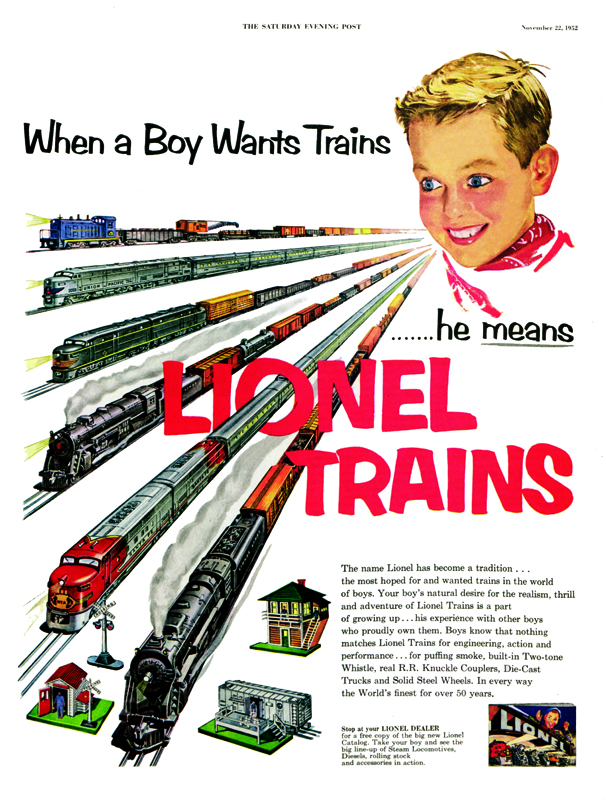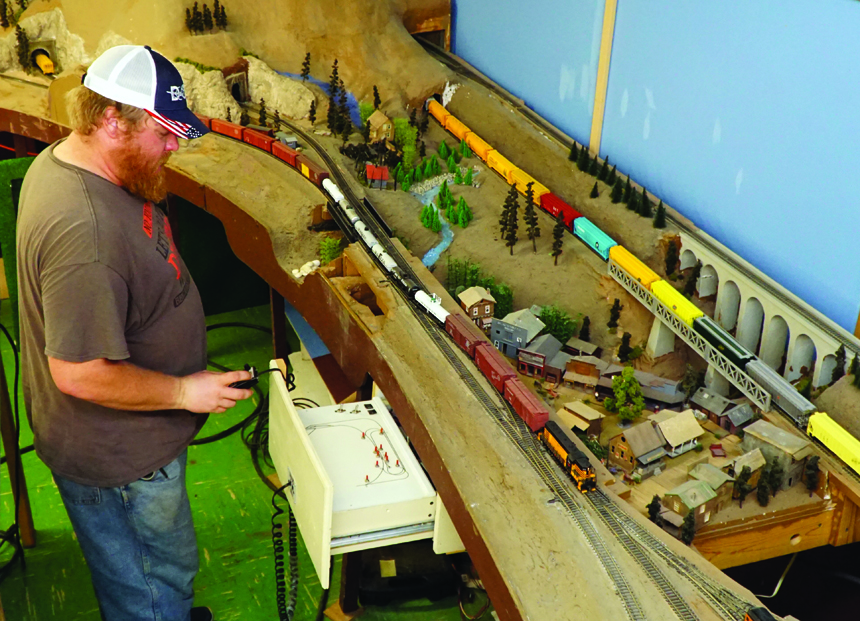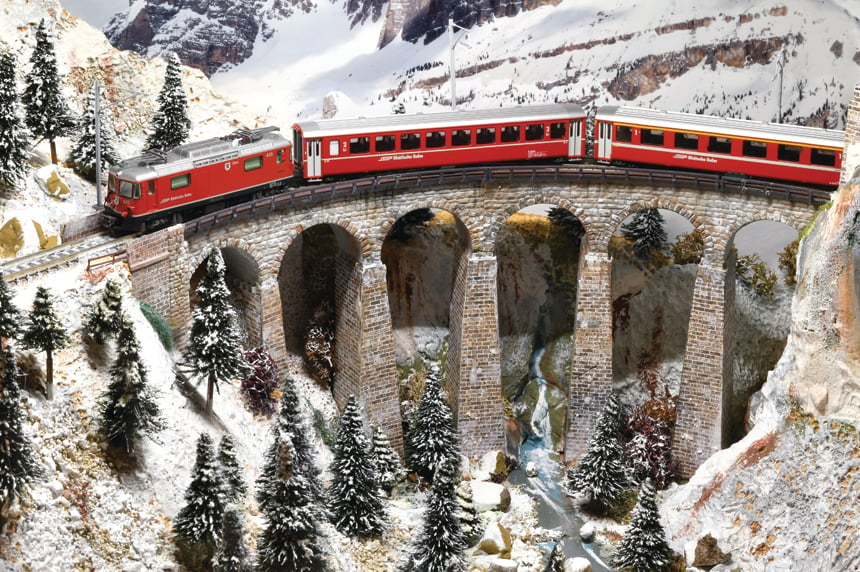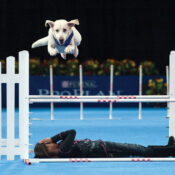Sal Gambino was about two years old when his father unboxed a train set and put it underneath the Christmas tree for the first time. Lionel steam engine No. 2025, a glossy black engine blazoned with white lettering, trundled down the shiny, silver rails with colorful freight cars in tow.
“All of a sudden, one Christmas, there was a train going around the tree, and it kind of grew from there,” Gambino says. “We used to set that platform up every year at the holidays — at Christmas, like everybody did back in the day.”
Gambino still isn’t sure what caused his father to splurge on a train set all those years ago; his father never had one as a child. What Gambino is certain of, however, is that the little engine fueled a lifelong fire in his heart for model trains — so much so that he became the president of the Lionel Collectors Club of America in 2021, more than 70 years later. Like countless Americans, Gambino can trace his love for trains back to happy childhood memories. And, fortunately for those in the hobby, the popularity of model railroading seems to be gaining steam.
For more than 120 years, electric trains have been among the most popular toys in America. Whether toys or models — train aficionados are quick to note the difference — they’ve brought joy to children and adults alike.
Historians and hobbyists can’t pinpoint when Americans started placing trains around Christmas trees. It happened sometime in the early 1900s, when rail travel was the most feasible way to go long distances, making trains a part of Americans’ everyday lives.
Model trains had existed since the 1830s, but Joshua Lionel Cowen was the first to propel them to national popularity. In 1900, he started the Lionel Manufacturing Co., and by 1909, Lionel advertising declared that its electric trains were “The Standard of the World.”
The company’s earliest trains, now referred to as their “prewar” products, were made of thin tin-plate. Lionel stopped production of toys during World War II to make compasses for the military. When production resumed, the company’s heavier, more powerful O-scale trains — built to 1:48 scale, meaning 1 model inch represented 48 inches (4 feet) of their real-life counterparts — were appealing to fathers and sons, Gambino says.
Lionel faced competition from train-makers such as American Flyer and Marx, but Lionel had what other companies didn’t: an aggressive, nationwide marketing campaign that made the company a household brand. TV spots and print advertising featured famous train-lovers like Johnny Cash, Frank Sinatra, and Joe DiMaggio. “During the ’50s and up through the mid-to-late ’60s, they were the predominant train-maker in the country,” Gambino says. “They were practically on every magazine, had ads in newspapers, especially around the holidays. … They advertised pretty much everywhere in those days. If you were going to buy a train, it was Lionel.”
Lionel was known for size and operating reliability. As time went on, however, the allure of toy trains gave rise to demands for more realistic-looking models. HO-scale trains, at a 1:87 scale, allowed modelers to have more rolling stock and build more track in smaller spaces. Hobbyists joined together to form model train clubs, building miniature towns and railroads on tables — called layouts — in basements and buildings. Model train shows and conventions sprang up too.

Other scales of trains followed. By the late 1980s, even after weathering economic recession, the hobby became a sensation, according to Gordy Robinson, president of the National Model Railroad Association. The NMRA, which establishes size standards for the hobby, peaked with nearly 30,000 members in the late ’80s. A 1989 story in the Chicago Tribune chronicled the growth of miniature railroading: “In the last few years, so many new model engineers have been surfacing that shops can’t stock enough of the tiny couplers and brake hoses, and lichen-moss trees and bushes that are the hobby’s building blocks.”
But like real railroads, the hobby fell on hard times. Radio-controlled cars and airplanes became more popular pastimes, and participation in the hobby waned. Baby boomers who grew up with model trains began talking about the catastrophic derailment they expected the hobby to face.
In 2019, the Idaho State Journal told the story of a model train club that was losing members. The headline: “CHUGGING ALONG: Local model train club keeps fading hobby alive.”
The story was yet another public airing of the myth that model railroading is heading for the scrapyard. Robinson has heard people talk about the hobby’s supposedly flailing future for much of his life, and he doesn’t buy it.
“People have been saying the hobby is dying as long as the hobby has been around,” Robinson says. “Model railroaders generally used to have a saying: [They had] interest when they were young people, go off to college, discover girls and fast cars, and do not pick the interest back up seriously until they retired. That’s not what we’re seeing anymore. Now, we’re seeing a large number of people engaged with the hobby throughout their working life. As soon as these people have children of their own, their children get involved.”
Since the pandemic began, participation in the NMRA’s Master Model Railroader program — an elite training course for the most dedicated hobbyists — has “exploded,” Robinson says. 2022 is the organization’s first year of growth since 1992, and it now has roughly 16,000 members. He believes the group can reach 150,000 members by the end of the decade.
Numbers on the manufacturing side of the hobby look promising, too, he says. Robinson cites the success of Tennessee-based model train manufacturer ScaleTrains, which he says has an average customer age of 35, meaning younger people are getting invested. “As I am 35 myself,” Robinson says with a laugh, “it’s nice to know that I am the average age of their customer.”
Robinson, a resident of the United Kingdom, is the NMRA’s first overseas president in the group’s 87-year history — and he has international evidence to back up his claims about the hobby’s growth. Train-makers in Europe have seen sales of rolling stock and parts climb anywhere from 60 percent to more than 200 percent in the last year, either despite or because of the pandemic, he says. When people were isolated at home, they turned back to the safety and joy of operating model trains in private, a trend that’s true in America, too.
“Those are astronomical numbers in any industry,” Robinson says. “To think that’s in model trains tells all the story that I’m trying to tell. That’s why I’m confident that we will see our organization … grow in that way over the coming years.”

Others in the industry hold more cautiously optimistic views. At Broadway Limited Imports, a high-end model train manufacturer, President and CEO Bob Grubba says the company has seen slight growth above recent inflation. Though he still eyes some contraction in the industry, time has told — and could tell — a different story.
Around 25 years ago, Grubba read two studies conducted 10 years apart. Both reported that the average age of a model railroader was 56, and that few young people were getting involved. “If new people hadn’t been entering into the hobby, the average age should have gone from 56 to 66, but it didn’t. It stayed the same,” Grubba says.
Model train dealers have prudent hope, too. Sales are strong at the nation’s largest model train store, Charles Ro Supply Co. in Malden, Massachusetts, which is celebrating its 50th anniversary. Charles Ro Jr. says his late father would be thrilled to see how excited young customers are when they visit the store and see trains running around the shop layout.
“We’re kid-friendly. On Saturdays, we’ll get 30 or 40 kids to come to the store,” Ro says. “That’s what the hobby needs.”
The hobby still has to compete with video games and other technological time-grabbers for young people’s attention. But some of the same technology that modelers feared would kill the hobby actually may be coming to its rescue.
Thanks to improved computer technology, today’s model trains can have high-quality sound and speaker systems with customizable horn functions made from sound recordings of real locomotives. LED lights flash like real engines’ headlights, and improved model-making tools mean features like door handles, hinges, and decals are precise. With DCC (digital command control) technology onboard, modelers can operate their trains using mobile controllers and apps on their digital devices.
The model railroading revolution took off in the early 2000s when Broadway Limited first put DCC and sound equipment in a locomotive. “It was expensive at the time — our models were substantially more expensive than other models you could buy,” Grubba says. “Within a few years, every manufacturer had to go find a sound system and install it, or they just couldn’t sell anymore.”
Those features appeal to modelers of all ages. As a member of the North Central Oklahoma Model Railroad Club in Ponca City, Oklahoma, 67-year-old retiree Kelly Martin wants his fleet to be as realistic as possible, a wish that modern technology is granting.
“The sound, with the DCC, makes it that much more alive,” Martin says of his fleet. “It heightens the enjoyment. That’s really a nice feature because it has come a long way.”
Twenty-eight-year-old Gage Geist shares those sentiments. By day, he’s a pilot for Alaska Airlines. But by night — or whenever he’s off work — he’s racing model trains around the tracks in the Columbia Gorge Model Railroad Club in Portland, Oregon. He loved trains as a boy, and he still loves them today.
“The draw to model trains for most guys and gals of my generation is the advancement in technology,” Geist says. “For a long time, there was a huge gap in technology for model trains, where you used to just plug in your transformer, turn it on, and the train would run around the track. Well, now, you can run trains from your phone. That certainly piques the interest of many people in my generation.”
Technology doesn’t just make the hobby more enticing to prospective young hobbyists. It’s also a tool to get them into the hobby in the first place. Hobbyists are using social media to show what model railroading is really about, taking the hobby out of the basement and putting it on a virtual world stage.
Modeler Luke Towan, for example, posts layout-building tutorials on YouTube that have garnered up to six million views. Also highly viewed are videos by model railroading celebrities such as Rod Stewart, whose highly detailed layout has been featured in Model Railroader magazine. Model train enthusiasts are posting photos and videos of their trains and layouts across platforms like Instagram, Facebook, and TikTok, garnering significant viewership as well.
Geist believes more people of his generation will join the hobby. So do older members of the Portland club, which primarily models 1950s-era railroads in the Pacific Northwest. The club turned 75 this year, making it one of the nation’s oldest, President Cynthia Leonard says. Yet its roughly 140 club members don’t entirely reflect that.
“We range from age 12 to 91,” Leonard says. “At this time, what we’re seeing [are] young people in their 20s and 30s coming into the hobby. They’ve graduated in their tech fields, and they’re seeing this sort of hobby where they can use their knowledge, but have fun with it.”
Some find that model railroading lines up well — almost too well — with their careers. Another member of the Ponca City club, 35-year-old Warren Lloyd, is a locomotive engineer for the nearby Blackwell Northern Gateway Railroad. “My grandmother bought me my first HO set back in middle school, and I just added on from there,” he says.
The collection continues to grow, too. Lloyd will soon have his hands on a model of a locomotive he operates at work: former Chicago & North Western Railway GP30 No. 815. If you ask him how many model trains he has, he laughs. “Start counting.”
Hobby leaders don’t dismiss the fact that retaining younger hobbyists will be challenging. But they have hope that, once younger members are hooked, they’ll stay that way.
“I think some of the technology, like Bluetooth control … adds interest to the kids,” Gambino says. “I think tech is working its way there — things that will help, but the kids have got to get exposed.”
While social media and new technology could help the hobby, some modelers seem to find a love for it more naturally than others. Some grew up with trains, and some find out about them later in life. Ro is reminded of that when he walks around his store and visits with new customers, families who are buying their first trainsets, and children who are wowed by the aisles and aisles of big, shiny trains.
“I’m not saying every kid is going to be interested in trains,” Ro says. “They may only be interested for a few years. But every once in a while, one of them could be in the hobby for a lifetime.”
But no matter what age someone becomes a modeler, what ultimately keeps a person in the hobby for so long is not the latest locomotive computer chip, the most detailed paint scheme, or the improved workability of controllers. Deep down in a modeler’s heart, there’s still a toy train running around the Christmas tree.
Gambino, who now runs Lionel trains with his four-year-old grandson, puts it this way: “It’s a great hobby. We just like trains. Period.”
This article is featured in the November/December 2022 issue of The Saturday Evening Post. Subscribe to the magazine for more art, inspiring stories, fiction, humor, and features from our archives.
Become a Saturday Evening Post member and enjoy unlimited access. Subscribe now




Comments
My husband was a train enthusiast for years. He passed away 9 years and I’ve been trying to sell the collection. Was glad to see that trains are become popular again.
Can you suggest where and how I could sell his items for the correct price? Been looking for years. He was a member of a few clubs. If you can help I would appreciate it.
My father and his brothers, at one point or another, worked for Frisco (train line) or Frisco Transportation (truck line). Played with trains from childhood on.
Now my family has a two-car 25 foot deep garage that is used as a Workshop. One side has gardening, yard work and bicycles and an extensive bicycle repair bench. The other side is an HO scale L-shape train layout (12′ x 8′).
Model trains are for all ages.
Some people recreate where they grew-up, some recreate actual train lines duplicating as best as they can the original depots and stations. I, on the other hand, am creating my dream town which includes KBHR radio and Acme Anvil Company (some will understand the references).
Model trains … a hobby that can be as simple or as intricate as the hobbyist wants.
True fans of this hobby possess a fundamental love of real trains having little to do with this or that tech gimmickry being used as bait to try and lure in those who don’t.
Great article for my husband, who is 82 but has always liked trains. This past Saturday we road the North Conway Scenic RR. When he was 7 years old, he drew a picture of the Unadilla Valley train going through the valley where he lived in South New Berlin, NY. His mom submitted it to the magazine Jack and Jill. They accepted it-!!! This was in the ’50s.